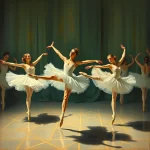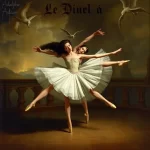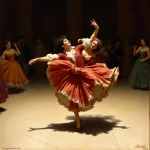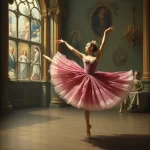Ballet: Jeux (Claude Debussy, 1913)

Introduction
Ballet: Jeux is a one-act ballet composed by Claude Debussy in 1913, with choreography by the legendary Vaslav Nijinsky. Premiering on May 15, 1913, at the Théâtre des Champs-Élysées in Paris, the ballet is a fascinating exploration of modernist themes and innovative dance techniques. The plot revolves around a playful and somewhat ambiguous love triangle set against the backdrop of a tennis game, capturing the essence of youthful exuberance and fleeting romantic encounters.
Historical Background
Creation and Development
The early 20th century was a period of significant transformation in the arts, marked by a shift towards modernism and experimentation. Jeux was created in this context, influenced by the burgeoning avant-garde movements in literature, music, and visual arts. The ballet was commissioned by Sergei Diaghilev, the impresario of the Ballets Russes, who sought to push the boundaries of traditional ballet.
The inspiration for Jeux came from a variety of sources, including contemporary literature and the social dynamics of the time. The collaboration between Debussy and Nijinsky was pivotal, as both artists were known for their innovative approaches. Debussy’s impressionistic music provided a rich, atmospheric backdrop for Nijinsky’s groundbreaking choreography, which broke away from classical ballet conventions.
Premiere and Reception
Jeux premiered on May 15, 1913, at the Théâtre des Champs-Élysées in Paris. The initial reception was mixed, with some critics praising the ballet’s modernist elements while others found it perplexing. Despite the lukewarm response, the ballet has since been recognized as a significant work that foreshadowed the radical changes in dance and music that would follow.
Notable early performances included revivals by the Ballets Russes and other prominent dance companies. Over time, Jeux has been reinterpreted and adapted by various choreographers, each bringing their unique vision to the ballet.
Synopsis of the Ballet
Jeux is a one-act ballet that unfolds in a single continuous scene. The narrative is simple yet evocative, focusing on the interactions between three characters: a young man and two young women. The ballet begins with the trio engaging in a playful game of tennis, which quickly evolves into a series of flirtatious and ambiguous encounters.
As the game progresses, the characters’ relationships become increasingly complex, with moments of jealousy, attraction, and playful rivalry. The ballet concludes with the trio disappearing into the night, leaving the audience to ponder the nature of their interactions and the fleeting nature of youthful romance.
Musical Composition
Composer’s Role
Claude Debussy, one of the most influential composers of the early 20th century, composed the score for Jeux. Known for his impressionistic style, Debussy’s music for the ballet is characterized by its fluidity, subtlety, and rich harmonic textures. The score is notable for its use of unconventional scales, complex rhythms, and innovative orchestration, which perfectly complement Nijinsky’s avant-garde choreography.
Musical Themes and Motifs
The music of Jeux features several recurring themes and motifs that enhance the narrative and emotional depth of the ballet. One of the most prominent motifs is a playful, syncopated theme that represents the tennis game and the characters’ interactions. This theme is interwoven with more lyrical and introspective passages, reflecting the shifting dynamics between the characters.
Debussy’s use of orchestral color and texture is particularly effective in creating an atmospheric and evocative soundscape. The music enhances the ballet’s sense of ambiguity and fleeting romance, drawing the audience into the characters’ world.
Famous Recordings and Performances
Several iconic recordings of Debussy’s score for Jeux have been made over the years, featuring renowned conductors and orchestras. Notable performances include those by the London Symphony Orchestra conducted by Pierre Boulez and the Cleveland Orchestra conducted by Pierre Boulez. These recordings capture the intricate details and subtle nuances of Debussy’s music, making them essential listening for fans of the ballet.
Choreography and Dance
Choreographer’s Vision
Vaslav Nijinsky’s choreography for Jeux was groundbreaking in its departure from classical ballet conventions. Nijinsky’s vision was to create a dance that reflected the modernist themes of the time, incorporating elements of natural movement and everyday gestures. His choreography emphasized fluidity, spontaneity, and a sense of playfulness, which perfectly matched Debussy’s music.
Signature Dance Numbers
One of the key dance numbers in Jeux is the trio’s playful tennis game, which serves as the central motif of the ballet. This scene is characterized by its dynamic and energetic movements, with the dancers mimicking the actions of a tennis match. Another notable moment is the trio’s flirtatious interactions, which are choreographed with a sense of spontaneity and improvisation.
The choreography reflects the characters’ shifting emotions and relationships, with moments of tension, attraction, and playful rivalry. Nijinsky’s innovative use of movement and gesture adds depth and complexity to the ballet, making it a unique and captivating work.
Notable Interpretations
Over the years, Jeux has been reinterpreted and adapted by various choreographers, each bringing their unique vision to the ballet. Notable interpretations include those by Kenneth MacMillan, who created a new version of the ballet for the Royal Ballet in 1980, and Jirí Kylián, whose contemporary take on the ballet was performed by the Nederlands Dans Theater in 1991.
These reinterpretations have kept Jeux relevant and fresh, allowing new generations of dancers and audiences to experience the ballet’s innovative choreography and timeless themes.
Characters and Roles
Main Characters
The main characters in Jeux are a young man and two young women, whose interactions form the core of the ballet’s narrative. The characters are not given specific names or backgrounds, allowing their relationships and emotions to take center stage.
The young man is characterized by his playful and flirtatious nature, while the two young women display a mix of attraction, jealousy, and rivalry. The ambiguity of their relationships adds to the ballet’s sense of mystery and intrigue.
Supporting Characters
As a one-act ballet with a small cast, Jeux does not feature any significant supporting characters. The focus remains on the interactions between the three main characters, whose dynamics drive the narrative forward.
Famous Dancers
Several notable dancers have portrayed the roles in Jeux over the years. Vaslav Nijinsky himself performed in the original production, bringing his unique style and charisma to the role of the young man. Other famous dancers who have taken on these roles include Rudolf Nureyev, Mikhail Baryshnikov, and Sylvie Guillem, each bringing their own interpretation and artistry to the ballet.
Cultural and Artistic Impact
Influence on Ballet and Dance
Jeux has had a significant impact on the world of ballet and dance, influencing subsequent works and choreographers. Its innovative choreography and modernist themes paved the way for future developments in dance, challenging traditional conventions and opening up new possibilities for expression and movement.
The ballet’s emphasis on natural movement and everyday gestures has been particularly influential, inspiring choreographers to explore new ways of incorporating these elements into their work.
Cultural Significance
Jeux holds a unique place in popular culture and the arts, reflecting the social dynamics and artistic trends of the early 20th century. Its themes of youthful exuberance and fleeting romance resonate with audiences, making it a timeless and relevant work.
The ballet has also been referenced and adapted in various forms of media, including film, theater, and literature, further cementing its cultural significance.
Legacy and Revivals
Jeux continues to be performed and celebrated today, with major revivals and reinterpretations keeping the ballet fresh and relevant. Its legacy is evident in the numerous productions and adaptations that have been staged over the years, each bringing new insights and perspectives to the work.
The ballet’s enduring appeal lies in its innovative choreography, evocative music, and timeless themes, making it a beloved and influential work in the world of dance.
Iconic Productions
Historic Productions
The original production of Jeux by the Ballets Russes in 1913 is one of the most famous historical productions of the ballet. Directed by Sergei Diaghilev and featuring choreography by Vaslav Nijinsky, this production set the standard for future interpretations of the ballet.
Other notable historical productions include those by the Royal Ballet and the Paris Opera Ballet, which have staged their own versions of Jeux over the years, each bringing their unique vision to the work.
Contemporary Productions
Recent productions of Jeux have continued to explore new interpretations and adaptations of the ballet. Contemporary choreographers such as Kenneth MacMillan and Jirí Kylián have created their own versions of the ballet, incorporating modern dance techniques and styles.
These contemporary productions have kept Jeux relevant and fresh, allowing new generations of dancers and audiences to experience the ballet’s innovative choreography and timeless themes.
Production Design
The production design of Jeux has evolved over the years, with various set, costume, and lighting designers bringing their unique vision to the ballet. The original production featured simple yet effective sets and costumes that reflected the modernist themes of the work.
Subsequent productions have experimented with different design elements, incorporating more elaborate sets and costumes to enhance the ballet’s visual impact. Lighting design has also played a crucial role in creating the atmospheric and evocative mood of the ballet.
Critical Reception and Reviews
Initial Critical Response
The initial critical response to Jeux was mixed, with some critics praising the ballet’s modernist elements while others found it perplexing. The innovative choreography and music were both lauded and criticized, reflecting the divided opinions of the time.
Despite the mixed reviews, Jeux has since been recognized as a significant work that foreshadowed the radical changes in dance and music that would follow.
Modern Reviews
Contemporary critics and audiences have come to appreciate Jeux for its innovative choreography, evocative music, and timeless themes. The ballet is now regarded as a pioneering work that pushed the boundaries of traditional ballet and paved the way for future developments in dance.
Modern reviews often highlight the ballet’s artistic and cultural significance, as well as its enduring appeal and relevance.
Fun Facts and Trivia
Behind-the-Scenes Stories
One interesting behind-the-scenes story from the original production of Jeux involves a last-minute change to the choreography. Nijinsky reportedly made several adjustments to the dance sequences just days before the premiere, adding to the sense of spontaneity and improvisation that characterizes the ballet.
Notable Performers
Several famous dancers have been associated with Jeux over the years, including Vaslav Nijinsky, Rudolf Nureyev, Mikhail Baryshnikov, and Sylvie Guillem. Each of these dancers brought their unique style and interpretation to the ballet, contributing to its enduring legacy.
Trivia
- Jeux was one of the last works composed by Claude Debussy before his death in 1918.
- The ballet’s title, Jeux, means “games” in French, reflecting the playful and ambiguous nature of the characters’ interactions.
- The original production of Jeux was overshadowed by the premiere of Igor Stravinsky’s The Rite of Spring, which took place just two weeks later and caused a scandal in the world of ballet.
Conclusion
Summary of the Ballet’s Importance
Jeux is a significant work in the world of ballet, known for its innovative choreography, evocative music, and timeless themes. The collaboration between Claude Debussy and Vaslav Nijinsky resulted in a ballet that pushed the boundaries of traditional dance and paved the way for future developments in the art form.
Final Thoughts
Jeux remains a beloved and influential work, celebrated for its artistic and cultural significance. Its themes of youthful exuberance and fleeting romance continue to resonate with audiences, making it a timeless and relevant ballet. Whether experienced through live performances or recordings, Jeux offers a captivating glimpse into the world of early 20th-century modernism and the enduring power of dance.
FAQ
What is the central theme of this ballet?
The central theme of Jeux is youthful exuberance and fleeting romance, explored through the playful and ambiguous interactions between three characters during a tennis game.
Who are the main characters in this ballet?
The main characters in Jeux are a young man and two young women, whose interactions form the core of the ballet’s narrative.
What is the most famous dance number in this ballet?
One of the most famous dance numbers in Jeux is the trio’s playful tennis game, which serves as the central motif of the ballet and is characterized by its dynamic and energetic movements.
How long does a typical performance of this ballet last?
A typical performance of Jeux lasts approximately 20 minutes, as it is a one-act ballet.
Are there any modern adaptations of this ballet?
Yes, there have been several modern adaptations of Jeux, including those by choreographers Kenneth MacMillan and Jirí Kylián, who have created their own versions of the ballet incorporating contemporary dance techniques and styles.
Why is this ballet considered important in the history of dance?
Jeux is considered important in the history of dance because of its innovative choreography, evocative music, and modernist themes. It pushed the boundaries of traditional ballet and paved the way for future developments in the art form, making it a pioneering work that continues to influence and inspire dancers and choreographers today.





